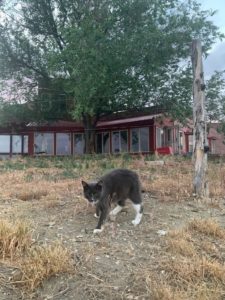
As we arrived at the Signal Peak Energy coal mine in the Bull Mountains, outside of Roundup, Montana, sunny skies and windblown conifers gave way to ominous mountains of coal. We were greeted by an endless conveyor belt that let out a deafening clamor as it piled high the spoils of the earth at a head-spinning pace.
In the back of my mind, I struggled to comprehend the sheer quantity of coal that loomed in front of me and the interdependent realities of energy-producing corporations and the individuals that consume that energy. More than 300,000 tons of pitch black rock stood before us in various stages of processing, ultimately destined for South Korean and other Asian energy markets, where the coal will be used to create electricity and fuel the daily lives of many people.
Historically, coal has been a significant source of electricity around the world, and Montana has been one of the flagship coal producers in the United States in recent years, accounting for around 40 millions tons, or approximately 5%, of coal mined annually in the United States. Much of the coal mined in Montana is exported to larger energy markets in the midwestern United States, and Asia is another growing market that has staked its energy infrastructure on coal power. However, Montana coal production has been steadily decreasing due to a number of shifting economic conditions that indicate change in the energy industry at large.
Alternative energy sources to coal, like natural gas, and renewables, like wind, solar, and geothermal, have become more accessible and more affordable in recent years, but coal corporations are reluctant to adjust their approach to energy production.
In a broad moment where many individuals and very few corporations are working to more fully understand human impacts on the Earth, corporate resistance to embrace the beneficial movement away from coal is inherent in the structure of corporations themselves. According to author and activist Jerry Mander, corporations are fundamentally obligated to expand and grow, regardless of community or individual health, well-being, or prosperity. Coal corporations are singularly engaged with the extraction and sale of coal, regardless of the environmental and social consequences.
Journalist David Roberts wrote about the rise and fall of coal as an energy source in the article “4 astonishing signs of coal’s declining economic viability,” where he highlighted the sudden boom and bust the coal industry experienced during the beginning of the 21st century. Roberts compared the differences in costs between coal power plants and renewable energy plants, based upon costs to maintain existing plants and construct new plants of both varieties. Already, new renewable energy facilities cost less to build than it costs to build or maintain new or existing coal plants, so coal corporations and their stakeholders may lose more than $600 billion as existing coal plants continue to lose feasibility before providing substantial returns on investment.
While corporate energy providers have been slow to embrace renewable energy, a few brave individuals have taken it upon themselves to move toward renewable energy in their own lives.
During the first two weeks of Cycle the Rockies, we visited Steve Charter and Jean Wallace, two pioneering advocates for renewable energy who had incredible foresight and courage in their efforts to explore alternatives to corporate energy production. Their commitment to alternative sources of energy is embodied in their homes.
Signal Peak and the Charter and Wallace families are on opposite ends of today’s energy issues.
The Charter family has become a landmark in the Montana energy and ranching landscape, where they organized the Northern Plains Resource Council to enable landowners to communicate with and stand up to insensitive corporations that neglect the delicate conditions of land and life in Montana. Decades ago, the Charters built an earth berm house with integrated passive solar heating to establish independence from energetically costly climate control on the family ranch, and they have since incorporated composting toilets, a series of unconventional regenerative ranching practices, and mentoring programs for young land managers.
The Wallace home made clear the collective impact of various supplemental actions to reduce commercial energy dependence. The unconventional home was built into the side of a hill using a passive solar design to maintain consistent temperatures year round, along with a wind turbine with the capacity to power the house for three days, if necessary. The Wallaces were early adopters of alternative design and energy concepts in the 1980s, and over time, they have further reduced their reliance on commercial energy by driving electric cars, expanding and maintaining battery storage capacity, and encouraging others to take small steps toward more conscious energy consumption.
Even if corporate coal companies are slow to embrace the future of energy, people like you and I can adjust our environmental impacts by making considerate energy consumption choices—shifting our life trajectories towards true energy independence.
Lukas Keller is a student at Colorado State University studying Fisheries, Wildlife, and Conservation Biology.
One Reply to “Prairie renegades show energy independence is a values-driven choice By Lukas Keller”
Comments are closed.
Gerat thoughts Lucas. Best of luck with your studies.